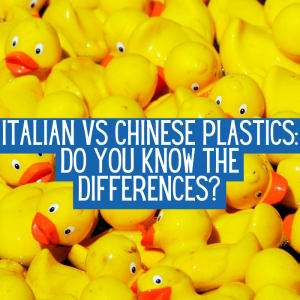 News and Events
News and Events
 Italian Certified Plastic vs Chinese Plastic: The Importance of Knowing the Differences
Italian Certified Plastic vs Chinese Plastic: The Importance of Knowing the Differences
Italian Certified Plastic vs Chinese Plastic: The Importance of Knowing the Differences
29-11-2023

The most crucial feature of the best children's toys is that they are made of certified and 100% Italian plastic. This is a critical element for the safety of the game and should be considered when purchasing toys for younger children in nurseries, preschools, and playrooms. At Italveneta Didattica, we have always prioritized safety and we always explain to our retailers that our creations come at a higher cost, but for valid reasons. Let's explore what these reasons are and why it is essential to choose the best Italian plastic, avoiding products made with imported plastics such as those from China.
.png)
The characteristics of 100% Italian plastic creations.
At Italveneta Didattica, we always recommend to retailers like you, creations made only with certified and 100% Italian plastic. These are excellent products that, unlike those Made in China, have unique features in terms of quality and safety. In detail, Italian plastic toys meet high production standards, and at Italveneta Didattica, we pay great attention to details and craftsmanship in product creation. Certified plastic is also a safe and non-toxic material, posing no health risks to children.
Equally important is the captivating and elegant design of Italian plastic.png) toys and educational aids that Italveneta offers to retailers. These are beautiful, safe, and original products that stand out for their unique style and appeal not only to the child but also to the adult.
toys and educational aids that Italveneta offers to retailers. These are beautiful, safe, and original products that stand out for their unique style and appeal not only to the child but also to the adult.
Our toys are creative and durable, fostering imagination and lasting longer than Chinese plastic, which, while less expensive, easily breaks and tends to melt at high temperatures, endangering the child's health.
Why you should Avoid Buying Chinese Plastic Toys?
At Italveneta Didattica, when presenting our catalog to retailers of plastic toys, we advise against purchasing low-quality products and Chinese plastic toys. The reasons are many and varied, let's look at some:
1. Poor Toy Quality: Chinese plastic toys are of lower quality than Italian 100% plastic toys, showing little attention to detail and assembly defects.
.png) 2. Material Safety Concerns: Plastics from China contain chemicals and are not as safe and non-toxic as the plastic in our toys. Additionally, in intense heat, these low-quality plastics release phthalates, heavy metals, and other toxic substances.
2. Material Safety Concerns: Plastics from China contain chemicals and are not as safe and non-toxic as the plastic in our toys. Additionally, in intense heat, these low-quality plastics release phthalates, heavy metals, and other toxic substances.
3. Environmental Disregard: Environmental sustainability is also important in choosing the best plastic toys. Unlike 100% Italian plastic, Chinese plastic is often associated with environmental problems, such as water and air pollution, as well as high consumption of natural resources. Choosing our product means prioritizing sustainability and making a decision that cares for the environment.
Chinese Plastic Melts in Heat
Many retailers like you might argue that Italveneta Didattica's plastic toys cost more than other products.png) from other companies. However, as always, a higher cost corresponds to a higher quality final product.
from other companies. However, as always, a higher cost corresponds to a higher quality final product.
Our plastic is 100% Italian, certified, and controlled. Unlike imported plastic, such as Made in China, it is non-toxic and safe. Particularly, and this is a significant concern with the arrival of the warm season, an Italveneta plastic toy does not melt in the heat and does not deform over time. Among the plastic substances that melt and deform with heat are:
1. High-Density Polyethylene (HDPE): Commonly used for milk bottles, detergent bottles, and food containers. It can deform or melt at relatively low temperatures, around 120-130 degrees Celsius.
2. Polypropylene (PP):Used in many everyday products like food containers, plastic cups, and kitchen utensils. It has a melting point around 160-170 degrees Celsius.
3. Polyvinyl Chloride (PVC): Commonly used for pipes, cables, and coatings. It can start to deform around 75-85 degrees Celsius and completely melt at higher temperatures.
.png) 4. Polystyrene (PS): Used to produce expanded polystyrene (styrofoam) containers and other disposable items. It begins to deform at temperatures between 70 and 80 degrees Celsius and can completely melt at higher temperatures.
4. Polystyrene (PS): Used to produce expanded polystyrene (styrofoam) containers and other disposable items. It begins to deform at temperatures between 70 and 80 degrees Celsius and can completely melt at higher temperatures.
5. Polycarbonate (PC): Known for its transparency and impact resistance, used for reusable bottles, sunglasses, and other products. It can deform or melt at temperatures above 140 degrees Celsius.
These are just a few examples of plastics that can undergo deformation or melting with the application of heat and should not be used for the production of aids, toys, and other products intended for young children.
If you also believe in the quality and safety of children, contact us to discover our catalog of 100% certified Italian plastic products.





